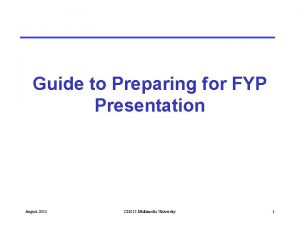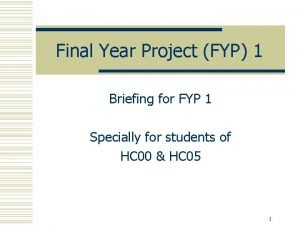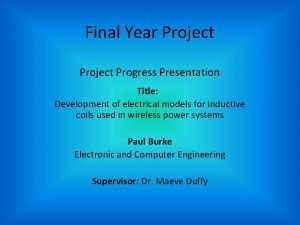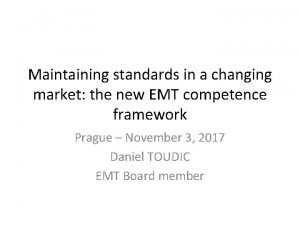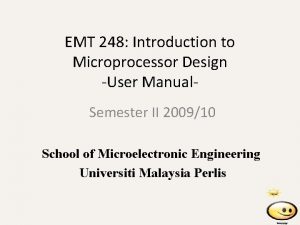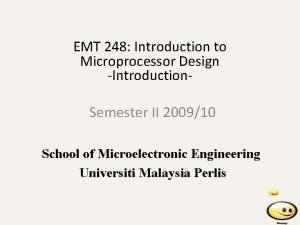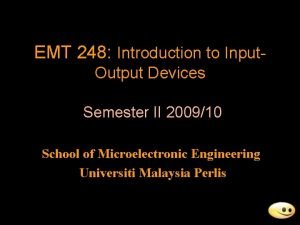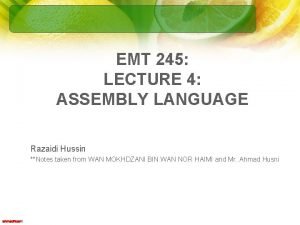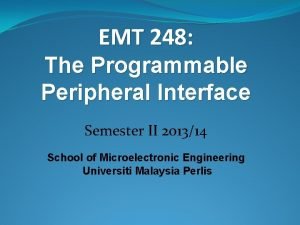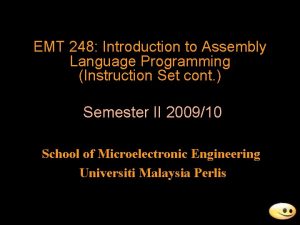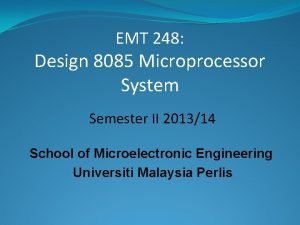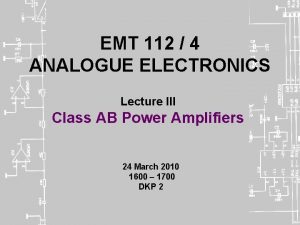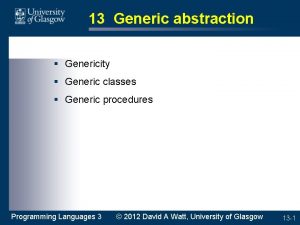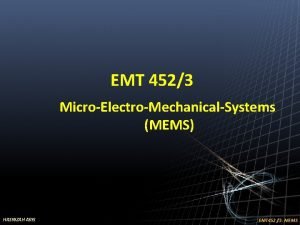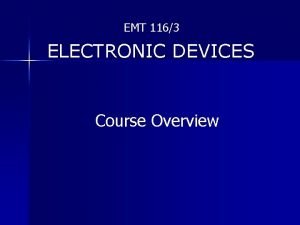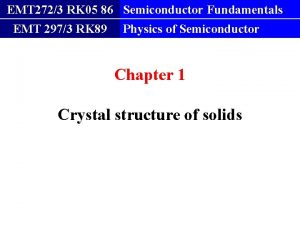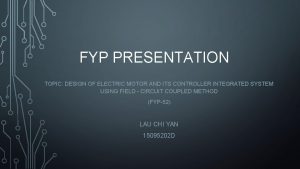FYP final presentation Topic Generic EMT Models for
























![References [1] H. An et al. , "Modeling and voltage-control of variable-speed SCAG-based wind References [1] H. An et al. , "Modeling and voltage-control of variable-speed SCAG-based wind](https://slidetodoc.com/presentation_image_h2/0a3bd111a6726d246fa70691f316b660/image-25.jpg)
![References [5] J. Mahseredjian, S. Dennetière, L. Dubé, B. Khodabakhchian, and L. Gérin-Lajoie, "On References [5] J. Mahseredjian, S. Dennetière, L. Dubé, B. Khodabakhchian, and L. Gérin-Lajoie, "On](https://slidetodoc.com/presentation_image_h2/0a3bd111a6726d246fa70691f316b660/image-26.jpg)

- Slides: 27

FYP final presentation Topic: Generic EMT Models for the New Generation Type-4 Wind Turbines Project ID: FYP_118 Yu Sing Lok (14124192 D) Supervisor: Dr. Ulas Karaagac

Content Introduction Objective Methodology Result Conclusion

Introduction Global warming becomes a serious problem in the world. The renewable energy is the clean and no pollution energy for the future. Therefore, providing a no pollution energy is a very important issue. Wind energy is one of the clean energy. Typically type-4 wind turbines (WT) is a full-size converter wind turbine with permanent-magnet synchronous generator (PMSG) via a back-to-back (Bt. B) link. However, some studies indicated that the production of the PMSG create a lot of pollution. The excessive pollution will decrease the expected benefits.

Introduction The PMSG is expected to be replaced with wound rotor synchronous generator or induction generator. This project will deliver the generic EMT models for the new generation Type-4 WTs. The model will be obtained by modifying the existing EMTP generic Type-4 WT model that uses PMSG.

Objective This project is concerned with: Studying the type-4 Wind Turbines Developing generic EMT model of Type-4 Wind Turbines (WTs) considering the recent advances. Being familiar with the Electromagnetic Transient Program (EMTP) Comparing its performances of with the conventional Type-4 WTs.

Methodology Since wind generator is too large, it is hard to use the real wind turbine to do the project. Electromagnetic Transient Program (EMTP) is a professional software for the engineer to simulate the different type of power systems. It is used to handle the extremely large power networks. I will use the EMTP to redesign the model and simulate the result.

Procedure of the project Understand the original type 4 Design the system in MSC Redesign the control system for SG Replace the PMSG to the SG Simulate the modified system with the testing system Compare the result with the original type

Type of generator The wound rotor synchronous generator (SG) The wound rotor induction generator (IG)

Induction Generator Self-commutated rectifier is much more expensive than diode bridge converter The efficient of the self-commutated rectifier is lower than the that of diode bridge converter. Main disadvantage of the WT is that the generator should have slip rings. An extra maintenance cost will be added for the slip rings.

Synchronous Generator The cost of synchronous generator is cheaper than that of induction generator. The diode bridge converter can be applied on PMSG and SG. It can easy to find out and test the function and performance of the diode bridge converter by comparing the result of SG and PMSG. Therefore, the SG was chosen in this project for wind turbine generator.

Machine Side converter (MSC) Diode Bridge replaced the machine side voltage source converter The diode bridge converter can be applied on PMSG and SG. It was used for the variable speed operation of the WT Constant Voltage for the DC-link

Problem in diode bridge and Suggestion

Diode bridge and boost converter in EMTP

Control method for the boost converter

Control method for the boost converter

SG in EMTP

Exciter System

Control for the Synchronous Generator

Testing system A 120 k. V and 60 Hz testing system

Simulation Type of fault Fault location GSC control mode Double line to Ground (DLG) Bus 4 Couple control DLG Bus 4 Decouple Sequence control Line to Ground (LG) Bus 4 Couple control LG Bus 4 Decouple Sequence control DLG Bus 6 Couple control DLG Bus 6 Decouple Sequence control LG Bus 6 Couple control LG Bus 6 Decouple Sequence control DLG Bus 3 Couple control DLG Bus 3 Decouple Sequence control LG Bus 3 Couple control LG Bus 3 Decouple Sequence control DLG Bus 1 Couple control DLG Bus 1 Decouple Sequence control LG Bus 1 Couple control LG Bus 1 Decouple Sequence control

Result: Bus 4 id & iq

Bus 4 Pc 2 and Ps 2 of bus 4 DLG Pc 2 and Ps 2 second harmonic pulsations P 0 active power output of FSC WT Q 0 reactive power output of FSC WT P 0 and Q 0 of bus 4 DLG

Bus 4 fault in developed model Bus 6 Bus 4

Conclusion and Further The PMSG was changed to a synchronous generator. A diode bridge was replaced with the machine side voltage source converter. A boost converter was used to step up the output voltage. The gate signal was used a PWM with a duty cycle which was controlled by the torque control. An excitation control was also designed for the wound rotor SG to achieve constant flux. The simulation results confirmed the satisfactory performance of the developed Type-4 WT with wound rotor SG configuration as it exhibited similar behaviour with the Type-4 WT with PMSG.
![References 1 H An et al Modeling and voltagecontrol of variablespeed SCAGbased wind References [1] H. An et al. , "Modeling and voltage-control of variable-speed SCAG-based wind](https://slidetodoc.com/presentation_image_h2/0a3bd111a6726d246fa70691f316b660/image-25.jpg)
References [1] H. An et al. , "Modeling and voltage-control of variable-speed SCAG-based wind farm, " Renewable Energy, 2011. [2] U. Karaagac, J. Mahseredjian, H. Gras, H. Saad, J. Peralta, and L. D. Bellomo, "Simulation Models for Wind Parks with Variable Speed Wind Turbines in EMTP-RV, " research report, Polytechnique Montréal, Dec. 2016. [3] O. Anaya-Lara, Wind energy generation : modelling and control. Chichester, U. K. : John Wiley & Sons, 2009. [4] B. Fox, Wind Power Integration: Connection and system operational aspects. Stevenage: Stevenage : The Institution of Engineering and Technology, 2007.
![References 5 J Mahseredjian S Dennetière L Dubé B Khodabakhchian and L GérinLajoie On References [5] J. Mahseredjian, S. Dennetière, L. Dubé, B. Khodabakhchian, and L. Gérin-Lajoie, "On](https://slidetodoc.com/presentation_image_h2/0a3bd111a6726d246fa70691f316b660/image-26.jpg)
References [5] J. Mahseredjian, S. Dennetière, L. Dubé, B. Khodabakhchian, and L. Gérin-Lajoie, "On a new approach for the simulation of transients in power systems, " Electric Power Systems Research, vol. 77, no. 11, pp. 1514 -1520, 2007. [6] R. Teodorescu, M. Liserre, and P. Rodríguez, Grid Converters for Photovoltaic and Wind Power Systems. Chichester, UK: John Wiley & Sons, Ltd, 2011. [7] T. Kauffmann, U. Karaagac, I. Kocar, S. Jensen, J. Mahseredjian, and E. Farantatos, "An Accurate Type III Wind Turbine Generator Short Circuit Model for Protection Applications, " Power Delivery, IEEE Transactions on, vol. 32, no. 6, pp. 2370 -2379, 2017. [8] U. Karaagac et al. , "Phasor domain modeling of type-IV wind turbine generator for protection studies, " ed, 2015, pp. 1 -5. [9] T. Kauffmann et al. , "Phasor domain modeling of Type III wind turbine generator for protection studies, " vol. 2015 -, ed, 2015, p. < xocs: firstpage xmlns: xocs=" /> .

END~
 Fyp final year project
Fyp final year project Fyp presentation
Fyp presentation Fyp presentation slides templates
Fyp presentation slides templates Fyp 1 presentation slides
Fyp 1 presentation slides Fyp progress report
Fyp progress report Generic software development process models
Generic software development process models Clincher sentence
Clincher sentence Narrowed down topic
Narrowed down topic Topic models
Topic models What is the difference between model and semi modals
What is the difference between model and semi modals Emt competence framework
Emt competence framework Emt setup
Emt setup Chapter 8 lifting and moving patients
Chapter 8 lifting and moving patients Emt chapter 24 trauma overview
Emt chapter 24 trauma overview Emt chapter 18 gastrointestinal and urologic emergencies
Emt chapter 18 gastrointestinal and urologic emergencies Emt 248
Emt 248 Emt 248
Emt 248 Emt 248
Emt 248 Emt 245
Emt 245 Chapter 32 environmental emergencies
Chapter 32 environmental emergencies Emt chapter 3 medical legal and ethical issues
Emt chapter 3 medical legal and ethical issues Chapter 22 psychiatric emergencies
Chapter 22 psychiatric emergencies Chapter 14 medical overview
Chapter 14 medical overview Jeanette emt
Jeanette emt Emt 248
Emt 248 Lxi assembly language
Lxi assembly language Emt 248
Emt 248 Emt 112
Emt 112

